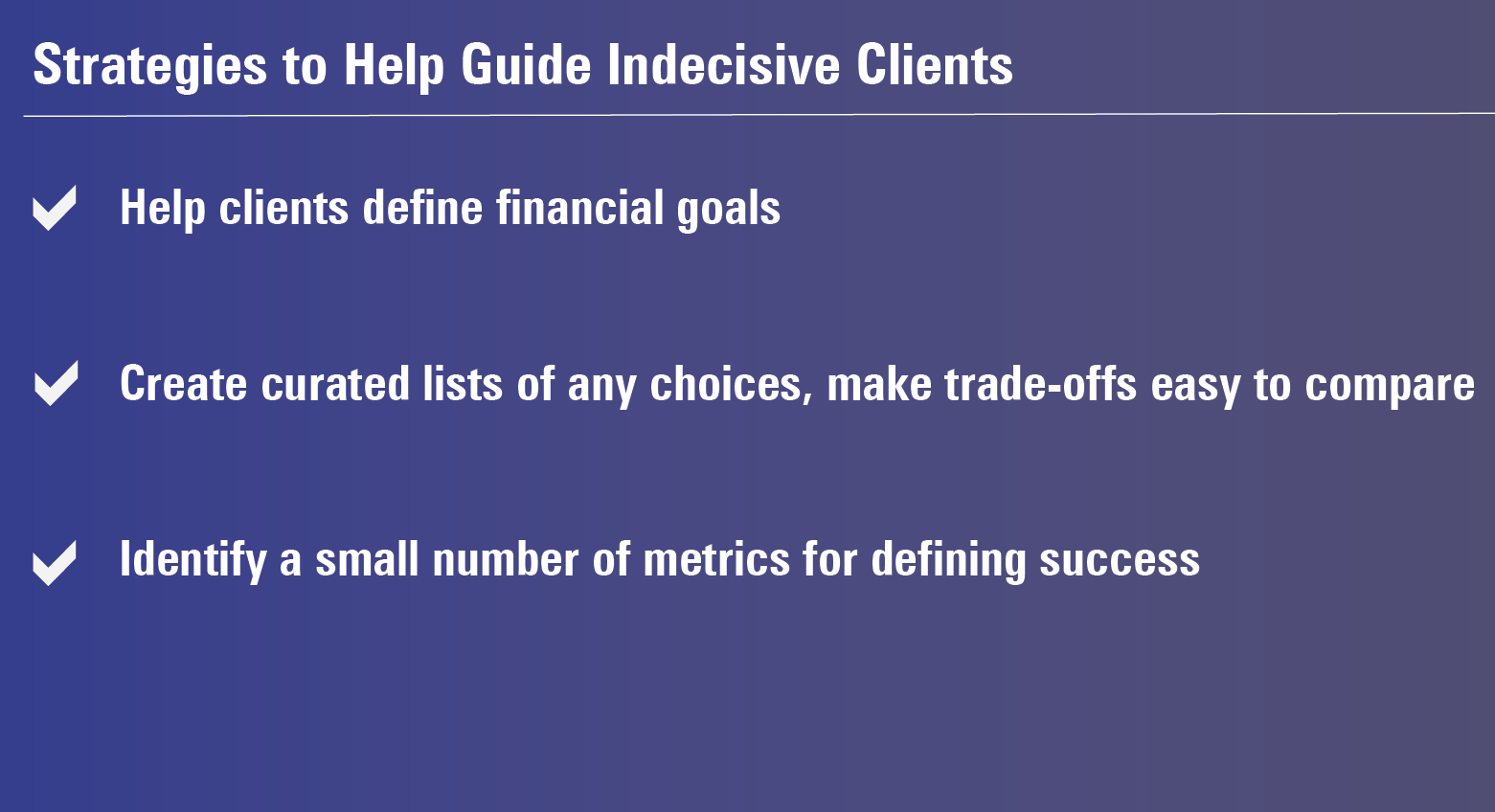3 Strategies to Guide Indecisive Clients
How to use decision-making aids in financial advising.
Financial decisions can be daunting for investors, and for good reason. These decisions usually need financial expertise, mathematical ability, or even a crystal ball. Every advisor has met with clients that can't seem to decide what route to take, what investment to choose, how much to save, and so on. Clients may delegate a decision to their advisor, or they can choose to struggle through the decision themselves. Some investors will face the struggle and come out victorious, others may turn to harmful decision-making shortcuts and/or make decisions they aren't quite happy with, leaving them dissatisfied and worse off financially.
To help talk clients through decisions they find challenging, it's important to first understand why investing decisions can be so difficult in the first place.
Decisions Are Hardly Ever Easy There are a few primary factors that make any decision difficult:
1) The complexity of the decision.
2) The difficulty of identifying the trade-offs between options.
3) Our lack of understanding of our own preferences.
We already know that financial decisions involve layers of complexity that overwhelm many clients, but it's also important to address the other two factors that make these decisions difficult.
Given the myriad investment choices and offerings, it can be challenging for everyday investors to identify the trade-offs between options.
Lastly, previous research shows that we aren't very good at understanding our own preferences, even in something as important as our financial future. Because of our biases--availability bias, hyperbolic discounting, and recency bias, to name a few--we can have trouble knowing what we want our lives to look like 30 years from now, let alone what we have to do to get there.
Guiding Clients With the Help of Decision-Making Aids The best strategies for helping indecisive clients are delegation, automation, and defaults, but each of these comes with a few cons to consider. Most notably, some clients may want to be more involved in the process and aren't comfortable completely letting go of the reins. For these clients, there are a few steps you can take to help them make those tough decisions:
1) Start by helping clients define their own preferences. In previous research, we found that a simple three-step process can help clients think more thoughtfully about their financial goals and break through the surface-level ideas we usually cling to. Starting with accurate and defined financial goals can put clients on the firm footing needed to make decisions down the road.
2) Help your clients reduce the complexity of investing decisions by providing them with a curated list to start with. Instead of presenting clients with all available options, start by showing them a few high-quality options that you hand-picked. Just be sure to have the full list of options on hand if they ask for more information. Also, when presenting clients with a list of options, organize them and any adjoining information in a way that makes it easier to compare them. We see this done often in consumer shopping, let's bring it to investing.
3) Work with your client to systemize emphasis on relevant investment attributes. There are an ever-growing number of financial metrics out there, but, most of the time, a client needs only a few to make an informed decision. Work with your clients to help them understand what metrics should be focused on, what they mean, and how important each is for their personal needs. Clarifying important attributes will give your clients the expertise they need to make informed decisions down the road.
As advisors, you're used to guiding clients through decisions, but indecisive clients may need additional tools. Incorporating these strategies may help ensure that your clients end up making decisions that they are satisfied with and fit their personal financial needs, all while causing the minimal amount of stress.

Source: Morningstar.

/s3.amazonaws.com/arc-authors/morningstar/e03cab4a-e7c3-42c6-b111-b1fc0cafc84d.jpg)
/cloudfront-us-east-1.images.arcpublishing.com/morningstar/6ZMXY4RCRNEADPDWYQVTTWALWM.jpg)
/cloudfront-us-east-1.images.arcpublishing.com/morningstar/6NPXWNF2RNA7ZGPY5VF7JT4YC4.png)
/d10o6nnig0wrdw.cloudfront.net/04-18-2024/t_1997613e43634249b59dd28db9b24893_name_file_960x540_1600_v4_.jpg)
:quality(80)/s3.amazonaws.com/arc-authors/morningstar/e03cab4a-e7c3-42c6-b111-b1fc0cafc84d.jpg)